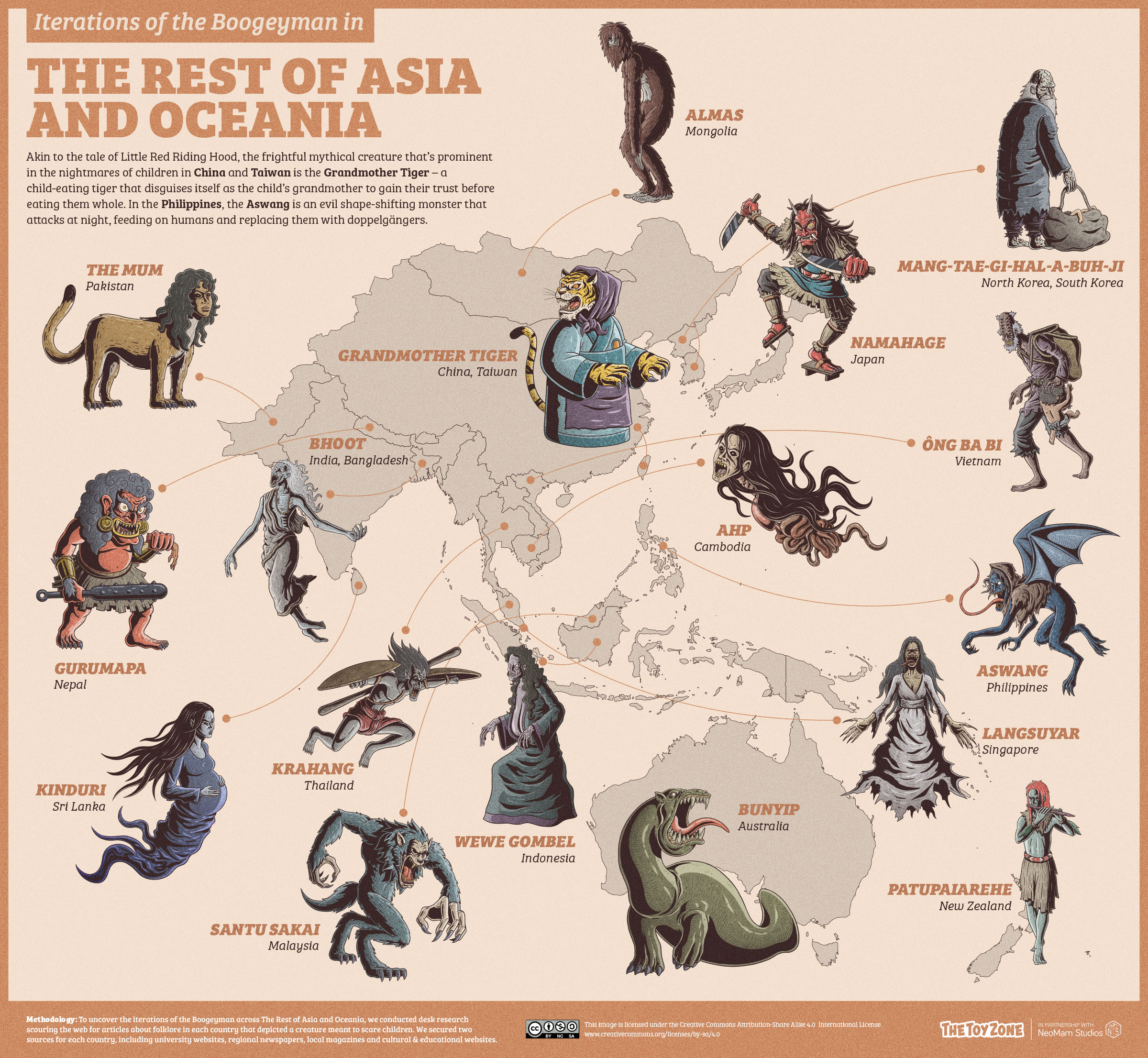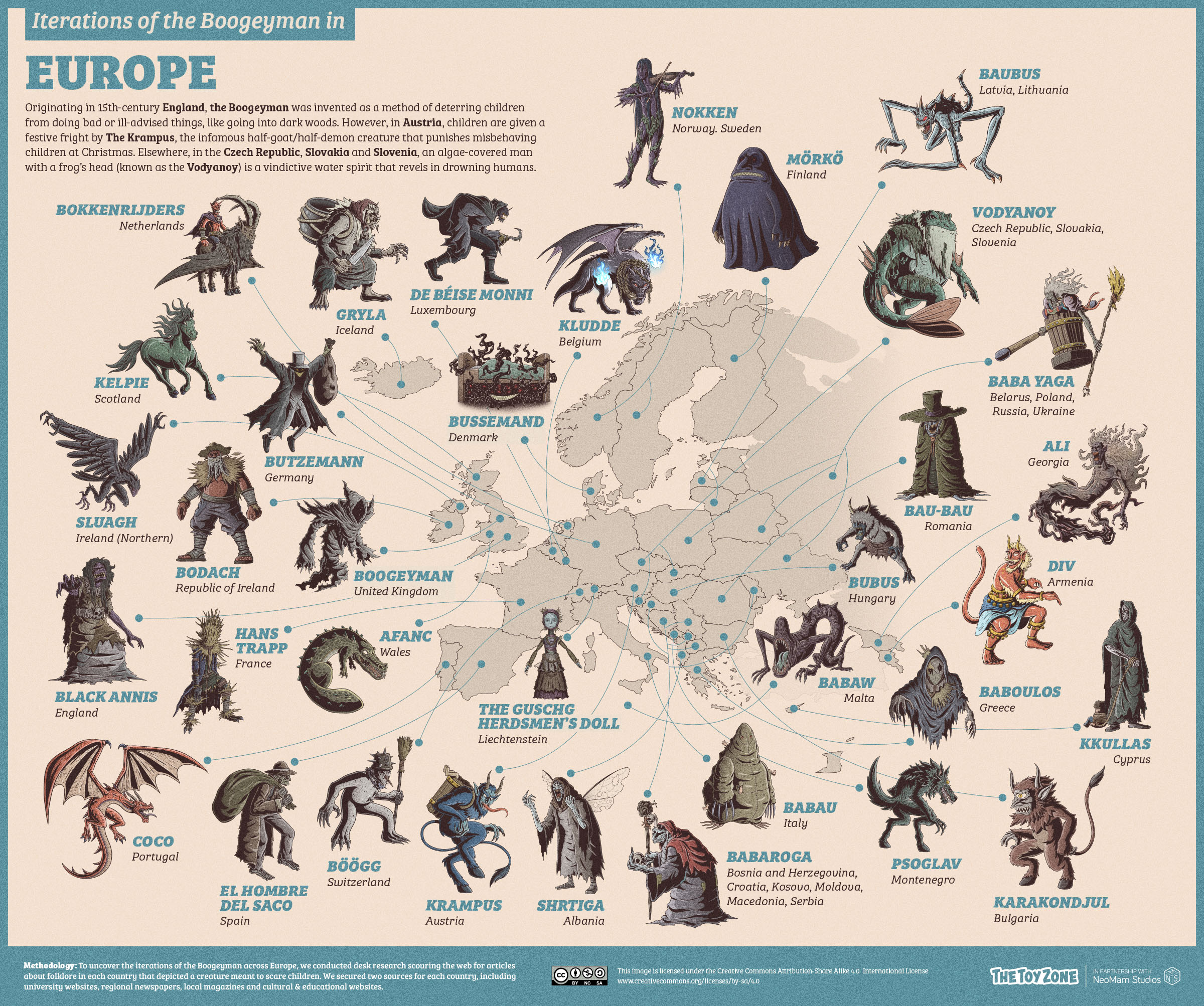Kids playing up? Sometimes positive reinforcement isn’t going to cut it. Sometimes, you need to bring in the big guns.
The Boogeyman. Krampus. Ninki Nanka. These frightening figures are found all over the world, where they’re available to enforce discipline at a moment’s notice. Luckily, the mere mention of a local boogeyman’s name — the Bunyip in Australia, China’s Grandmother Tiger — is sure to bring an errant preschooler into line before they can be whipped away in a sack/eaten/soul-sucked.
But could these mythical creatures be a positive influence on your children? It depends on how you invoke the beast: flat-out terrifying Junior into doing the right thing is not recommended. “Some parents try to scare children into following rules,” say researchers at Purdue University. “It is not a very effective way to control children’s behavior. Fear uses the lower levels of the brain, so children do not learn to think when parents use fear.”
On the other hand, mythmaking can be a fun and engaging way to defuse a potential flare-up. According to psychologists, allegorical figures and dramatization help a child to process their emotions and figure out how things work.
To help fuel your imagination and provide a cast for your cautionary tales, TheToyZone trawled through books and articles for examples of local boogeymen around the world.
Explore the world map below to learn more about the “local childhood law enforcers” from nearly every country across the globe:
| 🇲🇽 In a previous version of the below map, we had ‘La Llorona’ as the boogeyman of Mexico. This has now been updated to ‘El Coco’. We were aware that the myth of ‘El Coco’ is popular in Mexico, but we originally chose La Llorona as it was more unique to Mexico, unlike ‘El Coco’ which has numerous iterations that appear across South American countries and Portugal. After receiving several emails highlighting that ‘El Coco’ should be featured as the boogeyman of Mexico, we have updated the map. |
North America: Canada’s Seven O’Clock Man Has a Watch and an Attitude
The Boogeyman is America’s most notable take on the international boogeymen phenomenon, but more locally still, you’ll find the Jersey Devil. The cursed thirteenth child of an 18th-century NJ mother, the Jersey Devil may have “a horse’s head, long legs with hooves, two short front legs, and a bat’s wings,” according to official state sources; generally, witnesses are too frightened to hang around and note down the details.
The Quebecois call him Bonhomme Sept Heures — “good man” so as not to offend or anger the brute — but to the rest of us, that translates as the more mundane Seven O’Clock Man. The Seven O’Clock Man may be touched by the devil, but perhaps the most frightening aspect of this wandering bedtime enforcer is the cold matter-of-factness of his get-up: he’s literally just a dude with a sack and a great watch. You don’t have to be showy when you’re hard as nails, and Bonhomme Sept Heures lets his sack do the talking when kids threaten to stay up past seven.
South America: Tree Frog with Double Identity Warns Against Bullying
Often, a local boogeyman is tailored to (or emerges from…) its country’s unique landscape. Ecuador’s Kuartam is an Amazon-dwelling treefrog that deals with bullies by transforming into a tiger and eating them all up. His legend warns children to respect the rainforest and its bounties and doubles as a cautionary tale against teasing others.

“One female jumbee she wouldn’t behave/See how’s she’s jumping up on the grave/In one hand she’s got some rum/And she’s beating a conga drum.” Unfortunately, the upbeat jumbees in the calypso song Jumbie Jamboree are the exception rather than the rule; the jumbee is a conceptual cousin of the Haitian zombie (the words have the same roots) and is more about death and destruction than dancing and drumming. This malevolent spirit stalks Guyana and Venezuela in a veil of mist, preying on naughty children.
Europe: Witches Everywhere (and a Living Doll)
Boogeyman-type monsters are found in cultures worldwide, but the OG Boogeyman started across Britain as the Bogeyman in the 15th century or earlier. More specific to England, Black Annis was (or is…) a Leicestershire witch, described by the 18th-century poet John Heyrick Jr. thus:
“Vast talons, foul with human flesh, there grew
In place of hands, and features livid blue
Glar’d in her visage; whilst her obscene waist,
Warm skins of human victims close embrac’d.”
Although she might reach in through a window to grab a naughty child, Black Annis is rumored to spend much of her time wandering Dane Hills. Parents use her name to warn kids not to walk off, lest the witch scratch them to death, suck out their blood and hang up their skins to dry (later to be made into witch-wear).
Law enforcement monsters follow their own lineage across mainland Europe, with many eastern countries sharing a variation on the witch Baba Yaga. Liechtenstein parents can draw on a local legend: The Guschg Herdsmen’s Doll was initially made to give wandering shepherds some female company. Unsurprisingly, they didn’t treat her very well. One day, the ragdoll woke up and became sentient, with little but gruesome revenge on her mind.
Middle East & Central Asia: Djinns and Goblins
As Flaubert has it in his Temptation of Saint Anthony, the Nasnās have “only one eye, one cheek, one hand, one leg, half a torso and half a heart.” The child of a human and a djinn, the creature may also have the tail of a sheep and the wings of a bat; even without the wings, the Nasnās get along very well by hopping. They haunt Yemen, among other areas in the region, and embody a warning against leaving things half-finished (but also against bestiality and defying the will of God).

The Turkish karankoncolos is an evil goblin working to a strict timetable. The furry little humanoid only emerges during the winter solstice, spending the rest of the year underground, sawing the ‘world tree’ with its brethren, aiming to bring the world to collapse. If you happen to be born during their period of emergence, you are forever in danger of transforming into one during a subsequent solstice. Try leaving a colander on your doorstep at night — the karankoncolos will become fascinated and waste his best hours counting the holes before fleeing at daybreak.
Rest of Asia & Oceania: A Flying Head with Trailing Innards
The bunyip finds its roots in Australian Aboriginal folklore. He is a swamp-dwelling fellow with a round head and long neck, resembling an ox, hippopotamus or manatee; as one source troublingly puts it, “descriptions of the Bunyip vary so wildly that many scholars believe he is just a nominal catch-all for an assortment of different, regional monsters.” The bunyip may have evolved to warn children away from dangerous waters since he is rumored to defend against intruders using hypnosis, his crippling roar or simply by hugging them to death.

The “lady who has lost her torso but retained her internal (now external) organs” trope is common across east and southeast Asia. In Cambodia, this floating head/intestines combo is known as the ahp. The ahp likes to eat blood and human flesh; if she finds a fresh placenta to chew on, the baby and its family will suffer. Some say she can pass on her curse (and free herself up to reenter the cycle of reincarnation) by tricking another woman into consuming her body fluids.
Africa: Sirens and Serpents
Jorge Luis Borges wrote of the Lamias in his Book of Imaginary Beings: “From the waist up, their bodies took the form of a beautiful woman; below, that of a serpent. Some reports have called them sorceresses; others, malign monsters. They lacked the faculty of speech, but their whistling was melodious. They would lure travelers to themselves in the desert, and then devour them.” The poet John Keats describes these Libyan sirens thus: “Striped like a zebra, freckled like a pard,/Eyed like a peacock, and all crimson barr’d.” You can see why men fell into their trap!
Ninki Nanka is the West African Nessie (Nessie is the Scottish Champ). Children in Senegal and The Gambia dread the winged 50-meter serpent, whose look alone can kill. With his feathered crest and reflective scales, Ninki Nanka is a rather glamorous bog monster, though some say he resembles a hippo, which is both less glamorous and less frightening. The only thing that can kill him is the sight of his reflection, so carrying a mirror is a must.
A Boogeyman In Every Home
For some families, the Boogeyman is the extra parent who won’t guilt you for over-relying on their help or judge you for your parenting choices. For others (including the protagonists of the latest Stephen King adaptation), the local boogeyperson is a genuine threat rooted in generations of superstition and mythmaking. And where might they take us next? If the Seven O’Clock Man was created to scare kids out of staying up late, where’s the Boogeyman for screen time?
| METHODOLOGY & SOURCES To find out how iterations of the Boogeyman vary in every country around the world, we conducted desk research where we found existing articles of folklore in each country that depict a creature meant to scare children. For the purposes of this research, we defined the Boogeyman as a creature that parents tell stories about to children to keep them from misbehaving, being naughty or doing things that may bring harm to them. If a country has multiple creatures that fit this description, either the creature that most closely matches this description will be picked or the more well-known/famous creature of legend. If a country does not have a monster that matches this description, then a creature that is scary to or targets children in the folktales will be chosen. Some creatures will transcend countries due to similar cultures. In this case, another Boogeyman would be researched. Where no other creature that matches the Boogeyman description was found, then the original Boogeyman that was found in other countries was used. For the purpose of this research, high-quality sources were used as reference material for the Boogeyman. Sources were found using Google Search, with key terms being ‘Boogeyman in X country/culture/folklore’ and ‘X country folklore creatures/monsters.’ |









